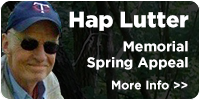by Kent Johhson | Mar 11, 2021 | Chapter News
WiseH2O App Project:
National Trout Unlimited is placing a high priority on Community Science and the benefits it provides for angler education and coldwater resource management. Trout Unlimited’s national science team partnered with MobileH2O, LLC to develop a customized mobile application (WiseH2O App) that can be used by anglers to monitor water quality and habitat conditions in Driftless Area trout streams. In 2019, Kiap-TU-Wish anglers participated in a successful WiseH2O App pilot project. The MobileH2O website: https://www.mobileh2o.com/anglerscience provides access to the Kiap-TU-Wish monitoring plan, the 2019 pilot project report, and an interactive map that enables viewing of all 2019 Kiap-TU-Wish WiseH2O App observations. COVID-19 and development of the iPhone version of the WiseH2O App delayed the start of the 2020 monitoring season until early August. Although the 2020 monitoring season was short, we are pleased to report that the iPhone version of the App is available, and the 2-in-1 test strips can be used to measure nitrite/nitrate concentrations. The App also has an updated look, with user-friendly educational messaging. Given the success of the 2019 Kiap-TU-Wish pilot project, and with further App improvements in 2020, WiseH2O App monitoring expanded to the entire Driftless Area (southwestern WI, southeastern MN, northeastern IA, and northwestern IL) in August 2020. Besides Kiap-TU-Wish, 14 additional Trout Unlimited chapters now have an opportunity to monitor our regional coldwater resources.
Those who are interested in WiseH2O App monitoring in 2021 can take the following steps:
- Download the WiseH2O App: Android and iPhone versions of the WiseH2O App are available for free download at the Google Play Store and Apple Store (search WiseH2O). Instructions for downloading the WiseH2O App can be found in the WiseH20 App User Guide, located on the MobileH2O website: https://www.mobileh2o.com/mh2oapp.
- Complete On-Line Training: Detailed on-line instructions for use of the WiseH2O App can be found in the WiseH20 App User Guide and the Video Tutorial for Using the WiseH2O App, both located on the MobileH2O website: https://www.mobileh2o.com/mh2oapp.
- Obtain Water Chemistry Test Kits: Depending on each participant’s level of interest and desired extent of involvement with water chemistry monitoring, 3 types of test kits are available. These three test kits can be ordered directly from MobileH2O, at: https://www.mobileh2o.com/shop. A reliable thermometer for WiseH2O App temperature measurements can also be purchased at: https://www.mobileh2o.com/shop.
For more information on the Driftless Area project, please contact Kent Johnson at d.kent.johnson@gmail.com.
Key interfaces for the WiseH2O App
A. Base Map
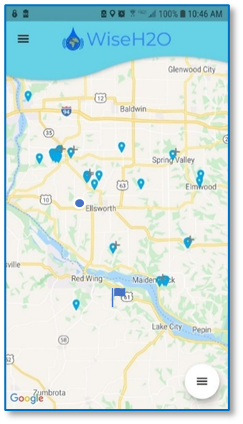
B. Observation Entry
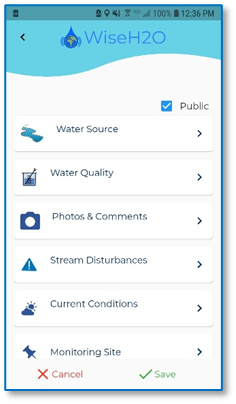
C. Observation Data
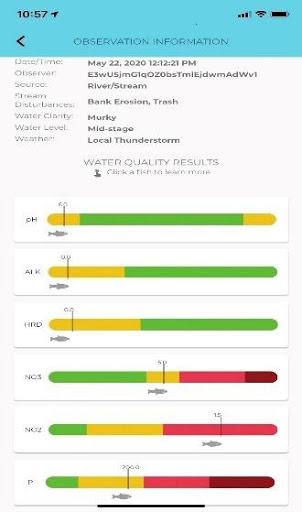
D. Results Map
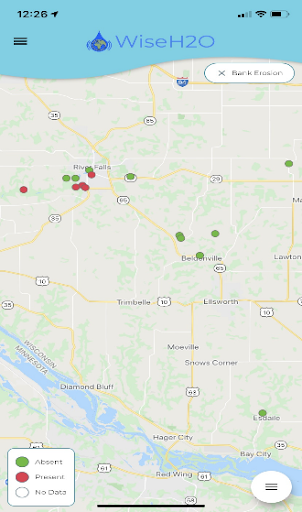
Submitted by John Kaplan and Kent Johnson March 8, 2021
by Ken Hanson | Mar 4, 2021 | Chapter News
Awards were presented to the following people during the Kiap-TU-Wish’s 2021 Online Conservation Gala Zoom event that was held on February 25th.
Tom Henderson – Golden Trout Award
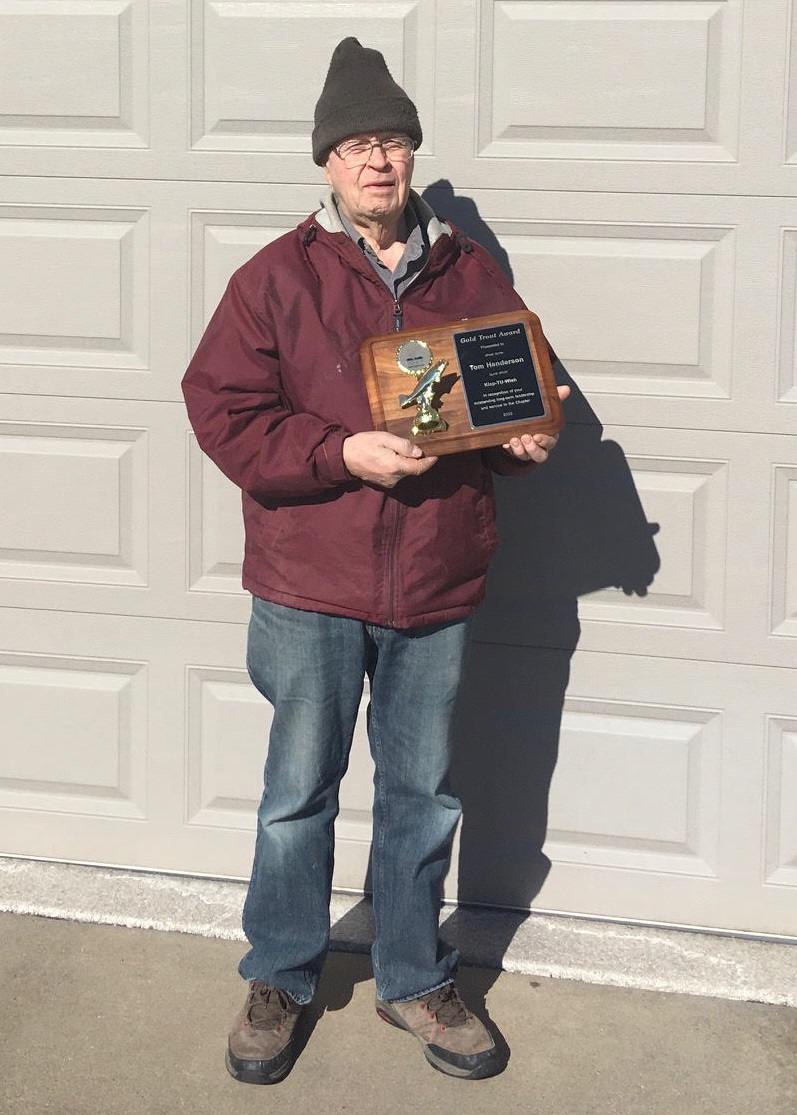
In recognition of his multitude efforts on behalf of KIAP-TU-WISH, Tom Henderson is hereby awarded the Golden Trout Award.
Tom has been a member of KIAP since 2007. In 2009 he was elected to the KIAP Board of Directors and in 2010 became Treasurer of the chapter. During his tenure as Treasurer, Tom revamped the chapter’s financial record keeping and began the process of creating formal yearly budgets, changes which were critical to the chapter’s management of its increasing stream restoration activities and funding. Tom played a major role in this increased funding through his multiple successful grant writing efforts, including one grant for more than $100,000 in federal funds. Due to his experience and success in the grant process, he was asked to speak on this topic at the TUDARE stream restoration workshop.
In 2011 Tom was appointed Vice-President of KIAP, followed by serving three years as President of the chapter starting in 2012. Tom provided leadership in strengthening KIAP’s working relationships with the chapter’s many stakeholder groups including the WI DNR fisheries and habitat managers, donors, county officials, the Kinni River and Western Wisconsin Land Trusts, and local sportsmen groups. One of Tom’s special interests was increased involvement with local schools, where he often served as a speaker for stream ecology events.
Beyond these formal leadership roles Tom has been a regular participant at project work days, assisted in Holiday Banquet organization, representing KIAP at sporting shows, and as a contributor to RipRap. Tom’s many and diverse contributions to the mission of KIAP-TU-WISH have enhanced our chapter’s management, outreach, and impact – for which the chapter is most grateful.
Loren Haas – Silver Trout Award
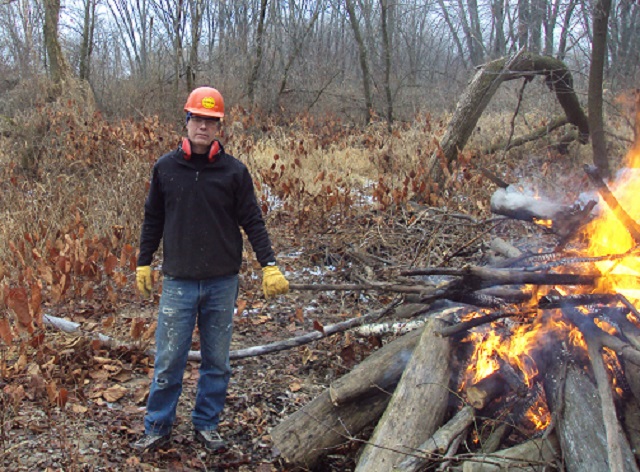
The Silver Trout Award is given to a chapter member in recognition of making an outstanding contribution to the conservation of coldwater streams and their watersheds. In his six years on serving on the Kiap-TU-Wish board of directors, in his leadership and participation as a sawyer in weekly volunteer workdays and in his leadership of the chapter’s Maintenance Committee, Loren Haas has certainly made an outstanding contribution to the conservation of coldwater streams and their watersheds in western Wisconsin. If clearing miles of buckthorn and box elder wasn’t enough, Lore Haas used his engineering expertise to help solve one of the most troubling, persistent threats to our Wisconsin coldwater streams. Sand runoff from floods and large rain events have been responsible for filling our coldwater streams with sand and silt, thereby clogging springs, covering trout spawning beds, smothering insect life and filling holes and shelter spots with sand and silt. Using his engineering skills, Loren Haas developed Elevated Riparian Structures, also known as “ERO” Structures, to help flush this sand and silt through stream systems, thereby restoring spawning, feeding and shelter spots for trout. Approximately 15 of Loren’s ERO Structures are already in place in western Wisconsin streams, actively restoring trout habitat in these streams even as we speak. We recently learned that the Department of Agriculture’s National Resource Conservation Service has added ERO Structures as an “approved in-stream habitat structure” for U.S. Government-funded streams across the entire United States! This means that Loren’s ERO Structures will likely be used to improve coldwater stream habitats across the U.S. for many years to come and certainly makes Loren Haas a worthy recipient of this year’s Silver Trout Award.
Maria Manion – Judy Lutter Communications Award

Maria Manion edited RipRap, the chapter’s newsletter, from September of 2014 through May of 2020. She produced fifty-four issues in that span of time, more than any previous editor. Maria devoted at least one weekend every month to that effort. And that effort showed. RipRap, in addition to being chock full of information, had a clean appearance, a logical and sensible layout and sharp illustrations that blended into an organic whole that was highly readable while presenting a striking graphic appearance. Maria recruited many contributors to write for the publication. Many of the “voices” who spoke through the pages of RipRap brought a new, diverse and refreshing perspective to it. It’s important to note that, while Kiap-TU-Wish has a remarkably active membership, that membership is scattered over an area large enough to make attending monthly meetings a challenge. For those members (and for the Chapter’s extensive “friends” mailing list), RipRap was both the voice and the face of Kiap-TU-Wish.
The time and effort that Maria expended on RipRap alone made her one of the chapter’s hardest-working members, but her work did not end there. Maria also served on the Board of Directors for six years. Her thoughtful and respectful approach to that job served as a unifying power on the board. Maria brought to the board the idea that, given the uncertainties of maintaining the newsletter as printed and mailed piece and the rapidly changing nature and volume of communication, RipRap could not only persist, but flourish as an electronic entity.
Any praise for Maria would be incomplete without mentioning that she brought herself, which is to say, kindness, an appreciation of beauty, a love for the natural world, competence and class to the Board of Directors.
The chapter is thus pleased to name Maria as the recipient of the first-ever Judy Lutter Communications Award and we thank her for the superb work she’s done for the chapter.
by Ken Hanson | Dec 16, 2020 | Chapter News
The Chapter is pleased to report that we have filled the vacant Board seat created by the resignation of Pete Kilibarda. Matt Janquart, an educator who lives in River Falls has agreed to serve out Pete’s term on the Board. Chapter members are still encouraged to contact TU National to update their profile with a current email address to get Rip-Rap directly. Otherwise, they are still reminded that it can be found on our Chapters webpage at http://www.kiaptuwish.org/ . As was reported in the last issue of Wisconsin Trout, the Chapter cancelled our annual Holiday Banquet. In lieu of our popular Conservation Banquet raffle that was a part of this event, Kiap is holding a 4 x 100 “Chance Offering” with four premium items; Norling Bamboo 5 wt rod $20/chance, Thomas and Thomas 3wt rod $10/chance, Joshua Cunningham framed oil painting, April Morning $10/chance and a Yeti 45 Tundra Cooler $10/chance. Make checks out to Kiap-TU-Wish and send your order to Tom Schnadt, 2174 Commonwealth Ave., St. Paul, MN 55108. Drawing will be February 28th or sooner. If you would like to pay on-line contact Tom at: thschnad@hotmail.com for instructions.
The chapter has formed a working group on Communications to tackle the various issues surrounding the production and use of social media, our website, and newsletter. Dustin Wing, Ken Hanson, Gary Horvath, Ed Constantini, and Scott Wagner held the first meeting on December 7th.
This year Orvis again teamed up with Trout Unlimited (TU) on their Embrace A Stream Challenge, an online competition encouraging anglers and conservationists to “Give Where You Fish.” The chapter is pleased to report that this effort yielded an additional $2410 to the $5500 EAS award given to us by National this summer. These dollars are to prepare a monitoring plan surrounding the Powell Dam removal efforts on the Kinnickinnic River in River Falls. On June 29, 2020, a large rain event damaged the Powell Falls dam resulting in an impoundment drawdown that began on October 2nd and was completed on October 15th. This has forced the City of River Falls to determine how best to manage the situation until the dam’s scheduled removal in 2023. Kiap TU Wish was asked to give our input and the Chapter contracted with Inter-Fluve, an experienced river restoration firm, to help craft our response.
Trout in the classroom
Five of our nine TIC programs still wish to participate this year despite COVID restrictions and threat of moving to on-line learning. Eggs will be delivered after the first of the year. Bugs in the Classroom and our ECO Day will not happen this year due to visitor restrictions at the schools.
Habitat Work
Following a key meeting this past summer when members of the Kiap TU Wish long range planning committee met up with Nate Anderson and Kasey Yallaly of the WIDNR on a walking tour of newly acquired easements within our chapter area, it was decided that our primary habitat improvement project for the coming two seasons would be a stretch of Cady Creek beginning at the bridge at County Road P and extending downstream for nearly 4,000 feet. This stretch of Cady is comprised of 3 easements. In many places along this stretch, 10-12’ high eroding banks are present. Cady has an excellent thermal regime and good populations of both brown and brook trout. There is also excellent gradient throughout this stretch of water.
Brush clearing on Cady Creek began on October 25th and work is moving along at a brisk pace even with the unseasonably warm weather keeping volunteers a little too warm at times. Work started on the east bank at the bridge and moved downstream cutting down box elder, buckthorn and honeysuckle as we went. We cleared out space for rock to be delivered on site once the ground freezes. To date, we have held 8 workdays there comprising just over 498 volunteer hours. Restrictions put in place by the DNR to manage Covid-19 exposure have limited our work crews to a maximum of 10 on site at any one time. We have been averaging 8 volunteers per workday. Cutting back on the number of participants to ensure adequate social distancing has had little effect on our brush busting abilities as it seems folks are eager to be outside getting some exercise. As of this writing, we had just begun clearing the south side of the steam, working our way due west. However, work here has been suspended for the year at the landowner’s request. There are several potential sites on the upper Kinni which need maintenance brush and tree removal to prevent past habitat work from once again becoming an imposing jungle of growth. Kiap’s volunteer coordinator and CCO (Chief Chainsaw Operator), Randy Arnold, has done an excellent job of moving things along. Additional volunteers are always welcome as many of our regulars may need a break around the holidays. Special thanks to volunteers from neighboring Twin Cities and Clearwater chapters and to Dave and Judy Babcock who were at the site on the Friday following Thanksgiving shooting aerial drone footage of this section while our crew was on the ground working below. The drone was flying at an altitude of 1300 feet and the volunteers look like little blaze orange ants on the ground as we sought to distinguish ourselves from deer during the WI hunting season. The Babcock’s said that they would return and shoot some more footage from a lower elevation once more of the trees had been removed. Here is a list of the volunteers who have helped thus far at Cady and the number of workdays which they attended.
Sydney Arnold 1, Eli Anoski 1, Randy Arnold 9, Perry Bowyer 1, Dave Brockaway 1, Jeff Dahl 1, Greg Dietl 2, Dan Donahoe 1, Don Fritz 2, Dave Gregg 6, Loren Haas 5, Trish Hannah 5, Alan Hopeman 1, Matt Janquart 1, John Kaplan 3, Pete Kilibarda 2, Ron Koehn 2, Dave Kozlovsky 3, Mary Lilly 1, John Nowicki 1, Chris Olson 1, Dahlia Olson 1, Jim Sackrison 2, Sarah Sanford 3, Jim Sauter 1, John Skelton 8, Scott Wagner 3, Dan Wilcox 1, Dustin Wing 3, Brad Wistrom 1, Matt Wysocki 2
With the north side of Cady Creek cleared Nate Anderson and his WI-DNR habitat crew have moved their equipment on site to their start point downstream near the snowmobile bridge. This section of Cady Creek is plagued by extremely high banks, erosion and sand deposition in the stream channel. The habitat crew will require two years to complete this 3,500ft section of stream. Project cost is a major factor in the timeline as an immense amount of material to stabilize the stream banks must be purchased. Cady Creek is designated as a brook trout reserve with a good thermal regime. It is projected to be a holdout against the threats imposed by climate change. It also serves as a source of native brook trout brood stock for the WIDNR hatchery. WI-DNR senior biologist Kasey Yallaly has come up with a restoration plan using habitat types that will increase the competitive advantage of brook trout. This has become increasingly important as brown trout have begun moving up from the Eau Galle River in greater numbers according to recent survey data. This project will also add to the 12,745ft of Cady Creek restored in 1999/2000 upstream from these new easements which were graciously provided by the Meyers, Schneider and Gilles families. The “Cady Creek Brook Trout Habitat Improvement Project” was made possible through Wisconsin trout stamp funds and a $5,000 Pierce County Conservation Aid grant that was matched by Kiap-TU-Wish. With the assistance of Kasey Yallaly, Nate Anderson, Dustin Wing and Loren Haas, Kiap TU Wish was also able to secure a generous $15,000 grant for this project from the American Sportfishing Association’s conservation and research foundation (FishAmerica Foundation) in partnership with the philanthropic arm of Brunswick Corporation, manufacturers of popular boating equipment including Mercury Marine, Tracker, Boston Whaler, Harris FloteBote and Cypress Cay Pontoons and many other brands (Brunswick Public Foundation). The FAF grant was given based on our project’s ability to improve sport fish populations, aquatic habitat, or water quality.
The brook trout populations have plummeted in the South Fork of the Kinni from the sand deposition in recent years. In early October 2020, Nate Anderson of the DNR installed nine Elevated Riparian Optimization (ERO) Structures on the South Fork. Sand started moving immediately, however, the true potential of the structures won’t be realized until the spring flood and a few major rain events.
The Plum creek 2-year project has been completed. At first glance, you realize this stream is dominated by woody structure and root wads which provides overhead cover and habitat for insects. It will require skill and precision to avoid snags and still result in fish hookups. The diverse habitat includes 2 ERO’s and 2 cross vane weirs. Evaluation and comparison will made annually for 3 to 5 years to determine which provides better deep-water habitat for brook trout.
Monitoring
Although summer is the peak of the Kiap-TU-Wish monitoring year, monitoring will continue during the winter months at several streams and rivers, including three restoration project locations (Pine Creek, Plum Creek, and the Trimbelle River) and the Willow River, where the Little Falls Dam (Willow River State Park) was replaced in 2020, re-filling Little Falls Lake. Deployment of 21 temperature loggers will continue through the winter, to evaluate the year-round impacts of climate change, to provide data for assessing the impacts of the new Willow River dam, and to evaluate the ability of our stream restoration projects to improve temperature regimes. In January, water samples will be collected and analyzed at the Pine Creek and the Trimbelle River project locations, to better understand water quality during winter baseflow conditions, when watershed contributions of pollutants are minimal. To complement stream temperature and water chemistry data, two weather stations are operated year-round, providing data on air temperature, relative humidity, and dew point. Kiap-TU-Wish also provides financial and volunteer monitoring support to the USGS, for their year-round operation and maintenance of the Kinnickinnic River and Willow River flow gaging stations.
WiseH2O mApp Project:
National Trout Unlimited is placing a high priority on Community Science and the benefits it provides for angler education and coldwater resource management. Trout Unlimited’s national science team partnered with MobileH2O, LLC to develop a customized mobile application (WiseH2O App) that can be used by anglers to monitor water quality and habitat conditions in Driftless Area trout streams. In 2019, Kiap-TU-Wish anglers participated in a successful WiseH2O App pilot project. The MobileH2O website: https://www.mobileh2o.com/anglerscience provides access to the Kiap-TU-Wish monitoring plan, the 2019 pilot project report, and an interactive map that enables viewing of all 2019 Kiap-TU-Wish WiseH2O App observations. COVID-19 and development of the iPhone version of the WiseH2O App delayed the start of the 2020 monitoring season until early August. Although the 2020 monitoring season was short, we are pleased to report that the iPhone version of the App is available, and the 2-in-1 test strips can be used to measure nitrite/nitrate concentrations. The App also has an updated look and educational messaging that should be more user-friendly. Given the success of the 2019 Kiap-TU-Wish pilot project, and with further App improvements in 2020, WiseH2O App monitoring expanded to the entire Driftless Area (southwestern WI, southeastern MN, northeastern IA, and northwestern IL) in August 2020. Besides Kiap-TU-Wish, 14 additional Trout Unlimited chapters now have an opportunity to monitor our regional coldwater resources.
Those who are interested in WiseH2O App monitoring in 2021 can take the following steps to prepare this winter:
- Download the WiseH2O App: Android and iPhone versions of the WiseH2O App are available for free download at the Google Play Store and Apple Store (search WiseH2O). Instructions for downloading the WiseH2O App can be found in the WiseH20 App User Guide, located on the MobileH2O website: https://www.mobileh2o.com/mh2oapp.
- Complete On-Line Training: Detailed on-line instructions for use of the WiseH2O App can be found in the WiseH20 App User Guide and the Video Tutorial for Using the WiseH2O App, both located on the MobileH2O website: https://www.mobileh2o.com/mh2oapp.
- Obtain Water Chemistry Test Kits: Depending on each participant’s level of interest and desired extent of involvement with water chemistry monitoring, 3 types of test kits are available. These three test kits can be ordered directly from MobileH2O, at: https://www.mobileh2o.com/shop. A reliable thermometer for WiseH2O App temperature measurements can also be purchased at: https://www.mobileh2o.com/shop.
For more information on the Driftless Area project, please contact Kent Johnson at d.kent.johnson@gmail.com.
Photos:
Winter 2020 1: Kent Johnson and Beaver Activity at the Pine Creek Restoration Project (Photo Courtesy of John Kaplan)
Winter 2020 2: Loren Haas on a South Fork KK ERO structure. Photo by Tom Schnadt
Winter2020 3: Cady Creek crew. Those in the photo include Scott Wagner, Sarah Sanford, Trish Hannah, Ron Kuehn, Matt Wysocki, Jim Sackrison, John Kaplan, Jim Tatzel and John Skelton.
by Ken Hanson | Nov 3, 2020 | Chapter News
The November issue of RIPRAP is on our website!
Due to increased printing costs, RIPRAP is no longer available in a printed format. Instead, you can view RIPRAP on our website. Link
November’s issue includes; The Drift (words from our president), a profile of artist Joshua Cunningham, stream monitoring updates, Paul Johnson’s view on tying your own flies, a how-to on stream-bank restoration by Nate Anderson, and a very informative article on efforts to increase stream velocities by Loren Haas. Bob Trevis continues his beginner’s series with an article on casting, and new contributor John Lawrence provides a light-hearted article on his efforts to prevent a skunking during an outing this past summer. A run-down on the chapter’s upcoming “Chance” fund raiser is provided, and lastly Scott Hanson shows an innovative crane fly larva pattern. Enjoy!







